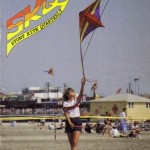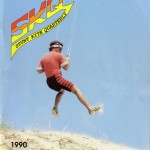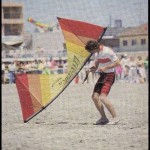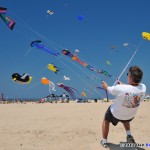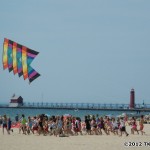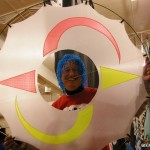Let’s start with some biography.
I was born in a small town about 10 minutes from Erie, Pennsylvania, called Waterford, in 1955. I went to school there and started working at General Electric right out of high school. I’ve been working there ever since. It was one of the best things that ever happened to me.
When I was around 25, I started throwing Frisbee a lot. I did a lot of freestyle Frisbee stuff. We did some half time shows and we did pretty good. We did some competitions and didn’t do too bad.
While I was still doing the Frisbee, I started throwing boomerang, too.
I was in San Diego around 1981 or so. I was at Mission Beach, throwing the Frisbee on a windy day. I heard a noise and I looked up and saw kites coming in. They came down and came right next to me. I was, like, “Holy cow, what is that?” And I looked up and there was guy standing on a mound, flying them, it was three Rainbow Stunt Kites. And then off they went and they came back down. And the guy is up there laughing and then off they went again.
The other Frisbee players said, “Aw, it’s just the goofy kite fliers.” But I was like, “Wow, I kind of want to do that! That looks good.” I went to buy some kites before I left San Diego but didn’t. Then I got home and got to thinking about it and sent my brother down there and he bought a couple for me and sent them home with my father. They were Hyperkites. I had them for a year before I ever got them to fly. And then my future wife moved in across the street and we took them out and flew. The two of us worked together pretty well and we ended up getting them to fly. And it was fun!
What was different, besides having her there?
We went to a spot that had steadier wind. Sue and I worked together and we kept at it, trying and trying. The day we went out was a good wind day, compared to the times before when my father and I went out.
The Hyperkites were triangular but they were only about two feet across and a foot high. They had sails that would collapse. They didn’t have stand-offs. They would collapse and fall out of the sky.
And then we went up to a small kite shop in Chagrin Falls, Ohio. That was probably in about 1984. Just being in that shop opened our eyes. And we got a couple kite magazines, and that’s what really did it. I devoured those on the way home.
I made a couple phone calls to people who advertised in the magazines. One was to Fran Gramkowski at High Fly Kite Company. We hit it off right away and we’ve been friends ever since. He was instrumental in getting me into the hobby. He ended up being one of our sponsors. And the thing that really advanced us, too, was Rainbow Stunt Kites, because you could self-launch those easily.
I couldn’t make my own Frisbees, but when I got into boomerangs, I immediately started making my own. And when I got into kiting, I immediately started making my own kites. That was key for a whole lot of stuff in my kiting life.
Tell me about the first kite you made.
The first one was just like a Trlby. I still have it. It was basically copied off of Trlby, about the same size and everything. It was in the winter and I remember the night I flew it. The wind was strong and it was snowing and it was cold, but it was a great time. I had a wonderful time that night. That just led to other kite making. I ended up making a whole train of Rainbow kites. After that, if there was a kite I wanted I could basically look at it and make it.
Had you sewn much before then?
Never. I’d never sewn anything. Sue was a good sewer. But sewing’s not hard. Basically for kites, everything’s a straight line.
What was it about kites that excited you so much more than Frisbees or boomerangs or other stuff you’d been involved in before?
There was so much more! With the Frisbee, you had the disc and that was it. There was a lot of stuff you could do with the disc, which we did, because we freestyled. And in boomerangs there was some stuff to do, but with the kites, it was like, wow, you could do this, you could do that, you could make more kites and put them together and they’d start to get powerful. There are single-line kites, lightweight kites, heavyweight kites. And I’ve always been a showoff. And kites are just plain showy.
Tell me about competing
We had a good friend, Al Hargus, who lived in Chicago. He was instrumental in getting us moved along. He told us about a competition and invited us to come and stay at his house. So we went to Chicago. I don’t remember the name of the competition. Sue and I figured we’d go and have fun hanging out with other kite fliers. By then, we’d only met a couple other fliers in Cleveland. So we went to Chicago and competed and we did quite well and that kind of got us started. And then, we went to several other competitions. We took quite a few first places here and there and it was thrilling. The first couple times we won first place, it was like, holy cow, we can do this!
Were you flying pairs with your wife?
Yes, but Sue and I weren’t married then. Nobody could quite figure it out and neither could we. We were kind of romantically involved. We were flying singles, and we were flying pairs.
So did you enter the first competition you ever saw?
Yeah. There wasn’t any ballet then, there was just precision. I took a first and I think Sue took a second at that first competition.
How did you manage that?
We liked to fly and it showed! We loved going out and flying. I guess it just showed when we performed.
Had you read previously about how to fly the figures?
Someone had diagrams of the figures at the competition and we looked at them and said, “Oh yeah, we can do this.”
We did a little practicing here and there but we were never into really practicing for a competition. That was before competition was what it is now. Now, you have to practice. Back then, people were just showing up and happy to be there. So it didn’t take near the skill to win as it would now.
We ended up going to competitions all over, the east coast, the west coast. This is unheard of now: we went to the west coast and actually came home with money! They had money! I think we won, like a thousand bucks.
And this was when?
This was in the 80s, probably about 1987 or so. Win or lose, it was always good fun to hang out with the kite fliers, regardless of what was going on.
Why do you think kite fliers are so fun to hang out with?
Maybe we’re kind of still like kids! I’ve heard the same thing from people who have shown up at the beach and they come and they hang out and it’s like, “Oh my gosh, you guys are, like, way fun!” As a group, that’s why we’re there. We’re there to have fun. Most of us are fun-oriented, in a lot of different ways, too. And I think that’s what draws a lot of people to it.
Were you in the kite business for a while?
We did a short stint of making and selling kites, for maybe about six months. We found out we didn’t want to do that because we wanted to spend more time flying than building.
You are very well known for a particular competition performance. I believe you flew to “Lady in Red.” Was that near the end of your competition career?
It was probably about in the middle. I’m going to say it was about two or three years into flying. By accident, I came up with using the dog stake. I was trying to figure out a way to launch from a small area for power kites. I had this dog stake in the ground and I launched a single kite and started walking. Then, I noticed that I could bring the kite over. I brought it closer to me and then I went downwind and then the kite was in my hands, and I was like, “Oh, my God, this is something!” That was another one of those joyous days of kiting – there have been so many joyous days of kiting – so after I got done, I was elated. I went home and said to Sue, “Wait until you see what I did!”
Tell me more about the “Lady in Red” routine.
Wildwood was coming up and that was the major competition of the year, and I didn’t have anything about a week before. I had been, I call it, “solo flying,” but I didn’t have a song or anything. So I was out flying on a Friday night, listening to the radio – because I hardly ever fly without music – and “Lady in Red” came on. I’m listening to the song and I think, “This is the song!” The next day, I started making a red kite with black in it. I don’t know if I even flew the routine much before Wildwood. Things just clicked! I started out flying normally and then I hooked into my dog stake and went into solo flying. I had it come over by my shoulder.
How did you make the transition to the dog stake?
I don’t remember. I had adapted the dog stake. Something I’ve always done for all my years of kite flying is adapt and modify and innovate.
How long did you compete?
After about five years, we decided we were done with competition. I personally got tired of the hurry up and wait. You ended up not flying, because you were waiting to compete. Sue was interested in judging more and I was interested in flying more. She judged and I would just be flying off to the sides somewhere. You know, if there was a break in the competition, I’d jump in with a demonstration. It worked out pretty good and neither one of us missed competing at all.
The good thing about doing well when we competed was that we got some sponsorships. So, we were some of the first who were able to fly with graphite rods, from a guy called, Red McLaren. He wanted to manufacture one of the kite designs we came up with, which was called a Spectrum Dart. So he provided us with some materials, which added to our fun quite a bit.
The Hawaiian Team Kite came out. Right after that, I started making big wing kites. And I started stacking those.
We went to Nationals every year and we’d probably go to five or six kite flies. We gained, I think, a little bit of a reputation that we could show up and fly a little bit of this and a little bit of that. You know, team flying and we both did different kinds of flying that a lot of people weren’t doing. That helped us get a couple of overseas trips. Anything overseas was not so much a competition, but more of a show. We went to France a couple times and Japan a couple times.
Give me an example of the kind of flying you were doing that others weren’t.
Stack flying. There were people who were flying kite trains. A kite train to me is a train of smaller kites and a stack is a train of larger kites. So, if you put eight Hawaiian kites together, or eight Revolutions, that was something that a lot of people weren’t doing. We were “dog staking” – I call it “solo flying” – and people weren’t doing that. And as far as I know, I was the first one to take a regular sport kite and fly it with four lines. So we had different things going on. We were good team fliers together. And we were both decent fliers on our own.
So we kept doing that, going to events where Sue would judge and I would fly for fun. And then, in about 1996 or so, she was diagnosed with cancer. We still went to a lot of things but eventually that caught up with her and she died in 2005.
How long had you been married?
Six years.
So what happened in your life after that?
I love flying, I really do. I really love to fly. So, I just kept on flying. I cut back a little bit on my travel, but I still flew a lot. I go to a couple of things in Cleveland and then maybe a couple other smaller things. I do three or four major things a year and that’s about it. But that doesn’t mean I don’t fly.
Let’s talk about your week-in, week-out flying. Do you have a field nearby? How often do you get to it?
I live on Lake Erie. I’m 15 minutes away from our major kite-flying beach, Presque Isle State Park, which, in my opinion, is the best spot in Pennsylvania to fly kites, because of the steady wind. I fly a lot. We hang out there a lot, whenever the weather is nice. There’s a bunch of us in the summer. In the summer, I hardly go anywhere else. It’s close, so I can fly whenever I want, if there’s wind. Mother Nature dictates my life. She determines whether I’m going to fly YFO, go kite surfing or go grocery shopping.
How did you get into kite surfing?
Around 1984, I started experimenting with flexifoils and ice skates. Then, we started kite skiing. As far as I know, I was the first one to go upwind on snow or ice. That’s why I’m out in all types of weather. Kite skiing is just awesome!
Do you use downhill skis or cross country skis?
Downhill. You really need to have an edge. People also use snowboards and some homemade apparatus. But mostly it’s either snowboards or downhill skis.
Does Erie get a lot of lake-effect snow?
Part of the area does but where we ski, there’s not as much snow. We ski on a bay of Lake Erie. Most of the time, the snow is blown off and it’s just ice.
Kite skiing is one of the innovations that I like to think I was the first to do. I’ve been doing it for more than 25 years. I’m still doing it and it’s still fun!
Tell me more about YFO.
I was coming home from Nationals one year and decided I needed a kite that I could fly in my driveway, because Sue had cancer and I knew I’d probably have to stay close to home. So I started thinking about what I could fly at home. And it had to be omnidirectional. And the only thing that’s omnidirectional is round. So that’s where I came up with YFO. I call it, “YFO.” If someone else makes it – Revolution made it for a little while – they called it “UFO,” because they didn’t like “YFO.” YFO is what I make, UFO is what everybody else makes.
Did you license the design?
There was talk of that but thankfully, I have a job and I didn’t want to go through all the bull crap, so I didn’t. There was no licensing, no trademark or anything like that. I decided a long time ago, I’m not in this hobby to make money. Thankfully, I don’t have to make money on it. So I make it and I fly it and if you want one, you need to make your own. There are plans online. I’ll tell you how. I’ll give you my phone number, if you have problems, I’m willing to help. It’s been unbelievable how much fun I’ve had with this.
Is YFO an acronym?
Sometime before YFO ever came out, I had what I call a FO series. FO stands for, “fun object.” There were several different fun object things that I’ve come up with. YFO, when I started it, was like a yo-yo. So that was where the “Y” came from. So it was “Yo-yo Fun Object.”
Tell me more about YFO’s development
Like with “Lady in Red,” in a day or two, I had it made and was flying it. I’ve done several modifications since then. It had to be flat. I haven’t found something totally round, like a sphere, that is going to work … yet. I’ve worked on it but I haven’t found it yet. So I just went with a flat disc, like a Frisbee. It was a single-line kite for a year or two. And then I figured, why not quad-line it. Then it became a different animal.
What’s it like flying a YFO? How is it different from other kites readers might have flown?
Flying it with a wand is different than flying with four lines. Flying the quad-line version; it goes every direction equally. When you start manipulating the handles, you’re flying not only the kite, now you’re flying the handles, because you’re manipulating them, along with the kite. When you put on music, it all starts to blend. It has not bored me at all. Every time I go out and fly, I come up with something new to do with it. I’m not seeing a stopping point. It’s really thrilling. A lot of times, you can’t get it to repeat the same maneuvers. It takes on a life of its own. It’s what I call, “reaction flying.” You’re reacting to what it’s doing; it’s not reacting to what you’re doing. With a Revolution or a dual-line kite, I call that 2D flying. You’ve got you and your kite out there. 3D flying is where you pull a kite toward you and then shoot it out. With YFO, I do a lot of 3D flying. I only use about 21 feet of line and do a lot of interacting with the kite.
When I get bored with YFO – and this is how my life has gone – when I get bored with something, then I come up with something that will entertain me more.
You’re known for flying stacks of Revolutions. How did that start?
I always flew stacks. Ever since I started flying, I’ve thought more is better. So I flew stacks of Rainbows, I flew stacks of Hawaiians, then we went on to make our own big delta wings and flew stacks of those. And then Revolution came out. I flew one and it wasn’t long before I was talking to the Hadzickis and saying, “I think I need a stack of these, too.” They sent some odds and ends and I started flying a stack of Revolutions. The stacks of Revs, they’re impressive. I love to show off and there’s nothing that will show off better than a stack of eight large, ominous kites and they come down and they land on their tips! I’ve been flying Revs for more than 20 years and it doesn’t get old. When someone sees this large stack of kites for the first time, when they launch and go up, you see their eyes, and they’re going, “Oh my gosh.” And then they come down and land. And then they walk. I don’t care what maneuver you do, but when you walk, it’s like “Oh my God, they walk!” It gives them personality and right then, you have everybody.
How do you see the current state and future of the hobby?
Competition is going to die off, because people aren’t traveling. And, you have to be too disciplined. The kids don’t seem to be getting into it and I don’t quite know why. Wildwood this year went kind of kerflooey.
I’d like to think people will make more of their own kites but it seems like people are getting lazier instead of more ambitious. Too many video games. And another thing that’s doing the whole kite thing in is Kids are doing organized sports all year. They’re not doing kites. I don’t know what will get them to do more kites. It’s kind of sad. Because it’s unlimited, what you can do with kites.
Do you do anything to spread your enthusiasm for kite flying?
I’ll do a couple things at schools. But you know, I’ve been doing this for 25 years plus. After a while, you just kind of settle back and you just don’t do it as much. It’s unfortunate.
We have some really good days at the beach. You would think that the whole city of Erie would want to fly kites. But Erie is a softball and bowling city. So forget about kites. We have a handful of people who are down there having the greatest time. But it just doesn’t seem to spread because it’s not normal. It’s not softball or bowling. It’s not what their friends are doing.
How do you interact with beach-goers who want to know what you’re doing?
I invite them to show up and start hanging out. This year has been pretty good about getting a few new people. We get people who drive two hours from Pittsburgh to watch kites for the day and then leave. They don’t do any flying themselves. I don’t know why.
Do you ever put set of lines in someone’s hands?
Yeah, I’ve done that quite a few times. YFO is the easiest, hardest kite to fly. I have given YFO to a two-year-old and he has been able to fly it. But if you want to do certain maneuvers, it gets to be a very difficult thing to fly.
Now a Revolution, you can’t necessarily hand that over to somebody, because it’s not the same.
What do you usually fly on the beach?
I’m a single-line guy. I’ll put some single line kites up. If there’s two major kites that I’m flying, it will be my stack of revs and YFO. I have stacked YFO, also. I’ve flown a stack of nine of them.
Is there anything we haven’t talked about that you wanted to?
You already know how much fun I’ve had.
If nothing else had ever happened to me in kiting, YFO has just been such a pleasure. It was such a simple thing. A small disk, but the pleasure that I that have gotten is just unbelievable. And it’s all because of music, too. I don’t fly without music. And the mere fact that I came up with myself is an added bonus.
Get a stunt kite, learn how to fly it, I’d go with quad line because you can fly in a tighter area. Practice a bit. Music is very key to doing it, because you can get lost. You can be out there and flying and not think about all the other stuff.
What music do you fly to?
Mostly top 40. I always like new music. I have some oldies, but it’s mostly top 40. You wouldn’t think it would be at my age but I like top 40. Before any event that I go to I try to put four or five new songs on my iPod that all the kids are listening to.
And finally, what’s been thrilling me lately is bubbles. You talk about showing off, it’s incredible. Next to kites, it’s the most wonderful thing I’ve ever done.
Well, how you got into bubbles is probably another interview.
Thanks for your time, Lee.
It’s been good talking to you.

